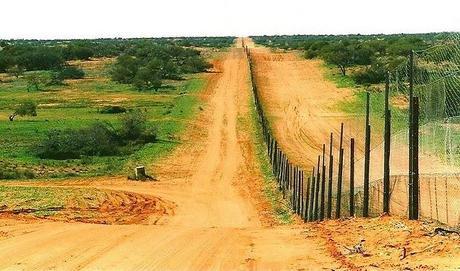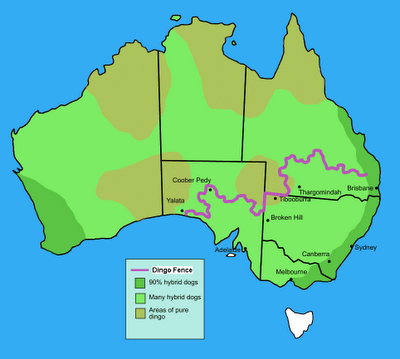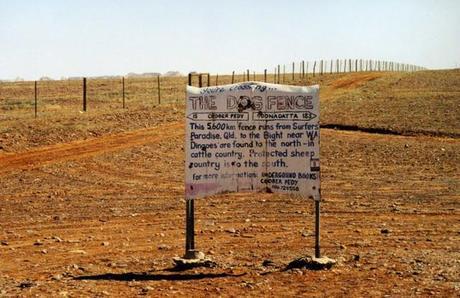
The Dog Fence, the worlds longest fence. The Dingo Fence or Dog Fence is a pest-exclusion fence that was built across the south east corner of Australia during the 1880s and finished in 1885. Originally purposed and built as a rabbit proof fence which proved unsuccessful, it was however well suited to keeping out feral pigs, brumbies, kangaroos and emus. In 1914 it was converted into a dog-proof fence to keep dingoes out of the relatively fertile south-east part of the continent in order to protect the sheep flocks of southern Queensland, New South Wales and South Eastern South Australia. By 1914 dingoes and wild dogs had largely been exterminated throughout the south east.
It is one of the longest structures on the planet, and the world's longest fence. It traverses a sometimes tortuous path through the outback and stretches in total some 5,500 kilometres from Jimbour on the Darling Downs near Dalby through thousands of miles of arid outback country to the Great Australian Bight ending on a high bluff at Nundroo. Estimates of the total length of the fence vary with the consensus being somewhere between 5,200 and 5,600 kilometres total length.

The fence in Queensland is also known as the Barrier Fence or Wild Dog Barrier Fence and stretches some 2,500 kilometres. It is administered by the Department of Natural Resources and Water.
It joins the Border Fence in New South Wales, where it stretches for 584km along Latitude 29. The fence passes the point where the three states of Queensland, New South Wales and South Australia meet (Cameron's corner), where there is a brass plate on the survey monument. It is known as the Dog Fence in South Australia, where it continues a twisting course towards the ocean over another 2,500 odd kilometers.
The fence is 180cm high made of wire mesh, and extends for 30 - 50cm underground. The fence line on both sides is cleared to a 5m width. Star pickets are spaced every 9m. The wire strainers are joined with Gripples.
Sheep and cattle stations in Australia protected by the fence are often very large. While varying in size, some of these stations can be larger than some small European countries. Prior to the completion of the fence, one station alone in South Australia lost over 11,000 sheep in a year due to dingo attacks. As recently as 1991, there were reported losses on one station of 3000 sheep in a single year. Sheep farmers have fought back by using poisoning, shooting, and eventually constructing the longest fence in the world. Aerial 1080 poison bait drops are still used today.
Parts of the Dingo Fence are lit at night by 86 mm (3.4 in) cold cathode fluorescent lamps which are alternately red and white. They are powered by long life batteries which are charged by photovoltaic cells during the day. A series of gates allow vehicles to pass through the fence.
Although it is only 1.8 metres (6 feet) tall, you can make out the path of the fence across Australia due to the presence of maintenance tracks which run along both sides using google earth. A good place to pick up the fence easily using google earth is Cameron’s corner where the Dingo fence joins the tri-border of Queensland, New South Wales and South Australia.
Despite the fence’s age it has never been officially surveyed, so an exact path is hard to pin down. Google Earth Forum user A185F has created a placemark file which gives you a rough idea of the fence’s route and its enormous scale.

The Dingo is a survivor and the top of the food chain in the Australian outback. Believed to have been introduced some 5,000 years ago they dominate as a predator and scavenger throughout their range. Today, dingoes are legally classified as vermin and carry a bounty of $20 AUS a head. Rewards for dingoes caught on the inside (southeast) of the fence can be upwards of $500 AUS.
Although the fence has helped reduce the loss of sheep to predators, the exclusion of these predators has allowed for increased pasture competition from rabbits, kangaroos and emus. The use of poison is a common practice in Australia by lacing waterholes with chemicals. There is strong evidence that shows kangaroo and emu numbers are lower outside the fence, but this could be related to the reduced amount of man made water sources outside the fence as much as to the fences exclusion of the dogs.
Today, the rate at which feral camel are smashing down sections of the fence is fast increasing in Southern Australia. Plans for restructuring the Dog fence to be taller and electric are being considered.

